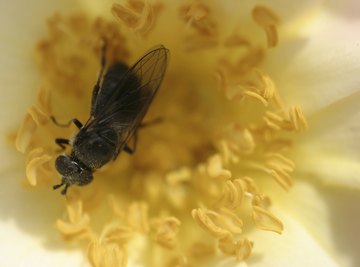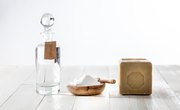
About one-third of the food we eat is actually pollinated by honeybees, according to Oklahoma State University. This includes fruit like strawberries and tomatoes. Preschool and elementary students are old enough to understand the process of pollination. Along with the pollination lesson, parents and teachers can introduce the students to a series of crafts and activities that will reinforce the process of pollination.
Flower Diagram
Bring two flowers into class. Show the students the flower, naming each of the parts while pointing to them on the flower. Let the children know that bees often pick up pollen when they rest on the first flower's stamen. Then when the bees travel to the second flower, some of their pollen falls off and rests on that flower's stigma. This is how the flowers are fertilized. Ask the children to show you what they have learned by drawing their own flower diagram, being sure to label each of the flower's parts.
Pollination Demonstration
Younger children often need a visualization of the concept being taught in order to fully grasp it. Demonstrate pollination with a simply activity. Give each child a picture of a flower, or have the children draw a picture of their favorite flower on a sheet of construction paper. Make sure each flower has a circular center. Allow the children to color the center of their flower in with a piece of chalk. Take a cotton ball and tell the children you are the bee. Stop by each flower and rub the cotton ball in the center of the flower. Show the children the cotton ball when you finish. They should notice that the pollen (chalk) transferred from the flower onto the bee (cotton ball).
Pollination Relay Race
Separate your students into two even teams. Give each team a bee. The bee can be a puppet, or a picture of a bee glued to a craft stick. Set a bucket 10 feet in front of each team, another bucket 10 feet away from the first bucket and a pretend beehive 10 feet away from the second bucket. Fill the two buckets with circular coins made from construction paper. Half of them must have a "P" written on the top for pollen and the other half "N" for nectar. Instruct the children to line up. One student from each team will go at a time, pretending to be the bee. The students must run to the first bucket, grab a pollen coin and a nectar coin, and head to the second bucket to deposit a pollen coin. Next, the students grab another nectar coin and a new pollen coin and run to the beehive to deposit all of the coins. Students then run back to their teammates and pass the bee off to the next person in line. The team who finishes first wins.
Honey Taste Test
Teach your students that after bees take nectar from the flowers they visit, the bees head back to their beehive and turn the nectar into honey. Bring a jar of raw organic honey (preferably local) into the classroom. Give each child a spoonful of the honey to taste. Ask the children to describe the taste. They should comment that the honey is sweet. Let the students know that honey is a healthy alternative to sugar. The children can try the honey in a glass of tea or drizzled over a waffle.
References
About the Author
Alicia Bodine has been a professional writer for 13 years. She has produced thousands of articles for online publications such as Demand Studios, GoBankingRates and WiseGeek. Bodine is passionate about gardening, travel, education and finance. She has received awards for being a top content producer.
Photo Credits
Hemera Technologies/AbleStock.com/Getty Images
